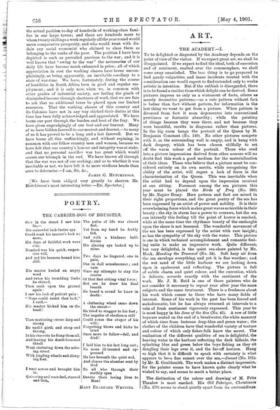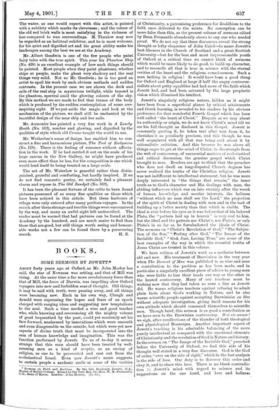ART.
THE ACADEMY.—L
To be delighted or disgusted by the Academy depends on the point of view of the visitor. If we expect great art, we shall be disappointed. If we expect to find the ideal, both of execution and of sentiment, exalted over the commonplace, we shall come away unsatisfied. The best thing is to go prepared to find gaudy vulgarities, and inane incidents treated with the consideration one would expect to find extended only to works artistic in intention. But if the rubbish is disregarded, there is to be found a residue from which delight can be derived. Some pictures impress us only as a statement of facts, others as merely decorative patterns,—as a rule pattern without fact is better than fact without pattern, for information is the last thing we want to get from a picture. When pattern is divorced from fact it soon degenerates into conventional prettiness or fantastic absurdity ; while the painting of things because they were there, and not because they were beautiful, results in diagrams rather than pictures. In the big room hangs the portrait of the Queen by M. Benjamin Constant (No. 149). No other pictures compete with it, as the surrounding wall is empty, and is hung with dark drapery, which has been chosen skilfully to set off the warm colour of the portrait. Those who read into a picture impressions derived from other sources will no doubt find this work a good medium for the materialisation of their ideas. Those who believe that a picture must be con- sidered entirely on its own merits, while recognising the ability of the artist, will regret a lack of force in the characterisation of the Queen. This was inevitable when the artist had to depend upon the impression received at one sitting. Foremost among the sea pictures this year must be placed the Birds of Prey (No. 383) by Mr. Napier Hemp. Here pattern and fact are mixed in their right proportions, and the great poetry of the sea has been expressed by an artist of power and nobility.. It is their overwhelming force which makes great waves so terrible in their beauty ; the sky in storm has a power to overawe, but the sea can intensify this feeling till the point of horror is reached, while at the same time the rhythmic beauty of the onslaught upon the shore is not lessened. The wonderful movement of the sea has been expressed by the artist with rare insight; so has the sympathy of the sky with the water. This picture is one in which technical accomplishment and romantic feel- ing unite to make an impressive work. Quite different, but very delightful, is the quiet sea-shore painted by Mr. Hook, Mending the Trammel (No. 34). Soft hazy air from the sea envelops everything, and yet it is fine weather; and the wet sand of the little harbour we are looking down upon is opalescent and reflecting. The picture is full of subtle charm and quiet colour, and the execution, which is delicate, accords exactly with the sentiment of the work. Mr. J. R. Reid is one of those painters who do not consider it necessary to repeat year after year the same subjects and the same treatment. There is a freshness about his work which comes to those who have many fields of interest. Some of his work in the past has been forced and
melodramatic, but he has always returned at intervals to a
vein of fresh sentiment vigorously expressed. This year he is most happy in his Sons of the Sea (No. 45). A row of little boys are seated on the end of a breakwater, the white masonry of which rises from lustrous deep-blue and green water; the clothes of the children have that wonderful variety of texture and colour of which only fisher-folk know the secret. The
realisation of the different qualities of sea is delightful, the heaving water in the harbour reflecting the dark hillside, the splashing blue and green below the boys fishing as they sit dangling their legs over it, and the far-off horizon. Hung
so high that it is difficult to speak with certainty is what appears to be, a fine sunset over the sea,—Sunset (No. 181), by Mr. E. Gouldsmith. The work makes a distinct impression, for the painter seems to have known quite clearly what he wished to say, and seems to merit a better place.
The distinction of the colour and drawing of M. Fritz Thaulow is most marked. His Old Pabrigue, Christiania (No. 470) seems to stand quietly apart from its surroundings.
The water, as one would expect with this artist, is painted with a subtlety which marks its cleverness ; and the colour of the old red brick walls is most satisfying in the richness of hue compared to wan surroundings. M. Thaulow may now be regarded as an habitual exhibitor, and he is most welcome, for his quiet and dignified art and his great ability make his landscapes among the best we see at the Academy.
Mr. Albert Goodwin is one of the few people who paint fairy tales with the true spirit. This year his Phantom Ship (No. 438) is an excellent example of how such things should be painted. Most people when they paint phantoms, whether ships or people, make the ghost very shadowy and the real things very solid. Not so Mr. Goodwin ; he is too good an artist to spoil his work by such obvious methods and sudden contrasts. In the present case we are shown the deck and sails of the real ship in mysterious twilight, while beyond is the phantom, spectral amid the glowing colours of the sky. By this method we are made to feel that trance of the body which is produced by the sudden contemplation of some awe- inspiring sight. If we put aside the magic and look at the mechanism of the picture, we shall still be enchanted by the beautiful design of the near ship and her sails.
Mr. Aumonier has painted a very fine work in A Lonely Heath (No. 513), sombre and glowing, and dignified by the qualities of style which old Creme taught the world to use.
Mr. Wetherbee's sense of design has enabled him to con- struct a fine and harmonious picture, The Pool of Endymion (No. 118).. There is the feeling of romance without affecta- tion in the work. If he had carried it out on the scale of his large canvas in the New Gallery, he might have produced even more effect than he has, for the composition is one which would lend itself to being treated on a large scale.
The art of Mr. Waterlow is graceful rather than distin- guished, grateful and comforting, but hardly inspired. If we do not find romantic poetry, we certainly find a pleasant charm and repose in The Old Sandpit (No. 919).
It has been the pleasant fortune of the critic to have found pictures possessed of so many fine qualities as those which have been noticed in this article. But these harbours of refuge were only entered after many perilous voyages. In the search after them strange and terrible things were encountered by the way, and many an awful sight left undescribed. The reader must be warned that bad pictures can be found at the Academy by the hundred, and are much easier to find than those that are good, but still things worth seeing and honour- able works not a few can be found there by a persevering











































 Previous page
Previous page